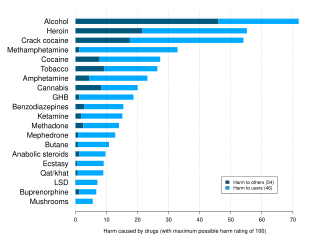酒精解毒
酒精解毒(英語:Alcohol detoxification,也稱為detox(戒癮、排毒、解毒))是讓有酒精依賴的個人馬上停止飲酒的意思。這種過程通常會伴隨使用替代藥物,這些藥物有類似於酒精的作用,以防止酒精戒斷症候群的發生。當戒斷症狀發生時,會產生各種症狀,嚴重程度不一。

因此把這個字當作「解毒」使用,可能會有點用字不當,因為整個過程並非專指從體內去除有毒物質。根據飲者的年齡、醫療狀況、和飲酒史,治療的程序有些或許也不算解毒。例如一個暴飲的年輕人在飲酒後的一週尋求治療酒精使用疾患時,就不一定要經過解毒的程序。[2]
戒斷症狀
編輯酒精戒斷的症狀有多種,包含輕微到嚴重不等,取決於個人所罹患的酒精依賴程度而定。症狀或是行為性(焦慮、情緒激動、易怒)、神經性(震顫、幻覺、或癲癇發作的風險增加)、和身體性(心率、體溫、血壓的變化,以及噁心)。症狀通常在停止飲酒後6至24小時內出現。在嚴重的情況下,可能會出現震顫性譫妄,這是一種醫療緊急情況,可能會導致死亡。[2]
處理
編輯苯二氮䓬類藥物是最常見用於酒精解毒的藥物類別,[3]其次是巴比妥類藥物。[4]
苯二氮䓬類藥物
編輯苯二氮䓬類藥物如氯二氮平(商品名Librium)、地西泮 (商品名Valium)、勞拉西泮(商品名Ativan)、或奧沙西泮(商品名Serax) 是最常用來減輕酒精戒斷症狀的藥物。有幾種治療模式。
開立苯二氮䓬類藥物的處方劑量可參考臨床機構酒精戒斷評估 (CIWA,修訂版簡寫為CIWA-Ar).[8]這份評估量表可在網上取得。[9]
關於這種藥物的種類:
- 由於氯二氮平的半衰期長,是用在單純型戒斷症狀的首選藥物。[10]
- 勞拉西泮或地西泮可針對那些無法安全透過口服方式用藥的患者,作為注射劑使用。
- 勞拉西泮和奧沙西泮因為可在肝臟外代謝,適用於肝功能受損的患者,。
一氧化二氮氣體療法
編輯利用一氧化二氮治療酒精戒斷症狀,是種有效且安全的方法。[11]在南非和芬蘭使用一氧化二氮精神止痛藥(psychotropic analgesic nitrous oxide,PAN),已成功治療20,000多戒斷症狀的案例。這種藥物在1992年正式被南非醫療當局批准用於治療成癮性戒斷症狀。因此,接受這種方式治療的患者可透過醫療保險申請報銷。這種氣體療法把具有高度成癮可能的鎮靜藥物(如苯二氮䓬類藥物和巴比妥類藥物)的使用減少90%以上。這種技術把對苯二氮䓬類藥物產生二度成癮的風險降低,對於使用苯二氮䓬類藥物作治療的患者而言,二度成癮是種真實而嚴肅的問題。[12]
其他藥物
編輯透過隨機對照試驗發現阿替洛爾[13]和可樂定有效。[14]另一項隨機對照試驗發現卡馬西平也有效。[15]
有些醫院運用酒精來處理酒精戒斷症狀,但這種做法存有潛在的問題。[16]
在治療酒精戒斷症狀時,經常會使用到各種維生素,特別是維生素B群。
γ-羥基丁酸鈉是種γ-羥基丁酸(GHB)的鈉鹽,被用於急性和中長期酒精戒斷症狀解毒之用。這種藥物可增強γ-氨基丁酸(GABA)的神經傳遞,並把麩胺酸的水準降低。γ-羥基丁酸鈉在意大利受到少量的使用,。
貝可芬(商品名Lioresal)已在動物研究和小型人體研究中,顯示出可增強解毒作用。這種藥物充當GABA B受體的激動劑,可能有效。
參見
編輯參考文獻
編輯- ^ Nutt, David J; King, Leslie A; Phillips, Lawrence D. Drug harms in the UK: a multicriteria decision analysis. The Lancet. November 2010, 376 (9752): 1558–1565. CiteSeerX 10.1.1.690.1283 . PMID 21036393. S2CID 5667719. doi:10.1016/S0140-6736(10)61462-6.
- ^ 2.0 2.1 Medical Detoxification from Drugs or Alcohol. Laguna Treatment Hospital. [2021-02-24]. (原始內容存檔於2016-12-14).
- ^ Mayo-Smith MF. Pharmacological management of alcohol withdrawal. A meta-analysis and evidence-based practice guideline. American Society of Addiction Medicine Working Group on Pharmacological Management of Alcohol Withdrawal. JAMA. 1997, 278 (2): 144–51. PMID 9214531. doi:10.1001/jama.278.2.144. Full text at OVID
- ^ Mohamed, Rashidi. Novel pharmacotherapeutic approaches in treatment of alcohol addiction. Current Drug Targets. 2018, 19 (12): 1378–4501. PMID 29788886. doi:10.2174/1389450119666180523092534.
- ^ Saitz R, Mayo-Smith MF, Roberts MS, Redmond HA, Bernard DR, Calkins DR. Individualized treatment for alcohol withdrawal. A randomized double-blind controlled trial. JAMA. 1994, 272 (7): 519–23. PMID 8046805. doi:10.1001/jama.272.7.519.
- ^ Daeppen JB, Gache P, Landry U, et al. Symptom-triggered vs fixed-schedule doses of benzodiazepine for alcohol withdrawal: a randomized treatment trial. Arch. Intern. Med. 2002, 162 (10): 1117–21. PMID 12020181. doi:10.1001/archinte.162.10.1117 .
- ^ Jaeger TM, Lohr RH, Pankratz VS. Symptom-triggered therapy for alcohol withdrawal syndrome in medical inpatients. Mayo Clin. Proc. 2001, 76 (7): 695–701. PMID 11444401. doi:10.4065/76.7.695.
- ^ Sullivan JT, Sykora K, Schneiderman J, Naranjo CA, Sellers EM. Assessment of alcohol withdrawal: the revised clinical institute withdrawal assessment for alcohol scale (CIWA-Ar). British Journal of Addiction. 1989, 84 (11): 1353–7. CiteSeerX 10.1.1.489.341 . PMID 2597811. doi:10.1111/j.1360-0443.1989.tb00737.x.
- ^ Holbrook AM, Crowther R, Lotter A, Cheng C, King D. Diagnosis and management of acute alcohol withdrawal. Canadian Medical Association Journal. 1999, 160 (5): 675–80. PMC 1230114 . PMID 10102003. (see appendix 2)
- ^ Duncan Raistrick; Nick Heather & Christine Godfrey. Review of the Effectiveness of Treatment for Alcohol Problems (PDF). National Treatment Agency for Substance Misuse, London. November 2006 [2011-11-29]. (原始內容 (PDF)存檔於2011-12-03).
- ^ Gillman M.A, Lichtigfeld, F.J. 2004 Enlarged double-blind randomised trial of benzodiazepines against psychotropic analgesic nitrous oxide for alcohol withdrawal, Addictive Behaviors, Volume 29, Issue 6, Pages 1183–1187
- ^ South African Brain Research Institute. [2021-10-04]. (原始內容存檔於2021-12-22).
- ^ Kraus ML, Gottlieb LD, Horwitz RI, Anscher M. Randomized clinical trial of atenolol in patients with alcohol withdrawal. N. Engl. J. Med. 1985, 313 (15): 905–9. PMID 2863754. doi:10.1056/NEJM198510103131501.
- ^ Baumgartner GR, Rowen RC. Clonidine vs chlordiazepoxide in the management of acute alcohol withdrawal syndrome. Arch. Intern. Med. 1987, 147 (7): 1223–6. PMID 3300587. doi:10.1001/archinte.147.7.1223.
- ^ Malcolm R, Ballenger JC, Sturgis ET, Anton R. Double-blind controlled trial comparing carbamazepine to oxazepam treatment of alcohol withdrawal. The American Journal of Psychiatry. 1989, 146 (5): 617–21. PMID 2653057. doi:10.1176/ajp.146.5.617.
- ^ Blondell RD, Dodds HN, Blondell MN, et al. Ethanol in formularies of US teaching hospitals. JAMA. 2003, 289 (5): 552. PMID 12578486. doi:10.1001/jama.289.5.552.